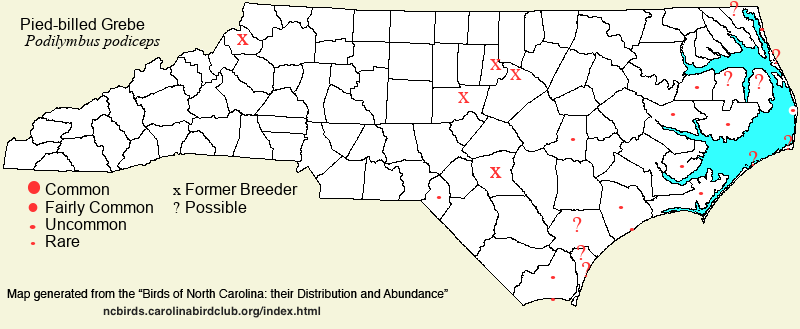 |  |
|
Pied-billed Grebe - Podilymbus podiceps PODICIPEDIDAE Members: | Search Common: Search Scientific: |
|
|
|||||||
| General Comments | The Pied-billed Grebe is one of our more unusual waterbirds. Despite it being reasonably common in much of the state, at various times of the year, one seldom sees it in flight, and birds on small ponds almost always sink or dive underwater and pop up to the surface near the far shore of the ponds. Even when seen in flight, the birds seldom rise more than a foot or two above the water, if disturbed (such as by motorboats). Not surprisingly, this species migrates solely at night, and it certainly has a strong enough flight to carry individuals many hundreds to a thousand or more miles from the breeding grounds to the wintering grounds, and back again in spring. This species is primarily found on freshwater ponds and lakes, but it also occurs on slightly brackish waters, as long as they are rather still. Grebes nest at ponds, impoundments, or along lake shores, where there is much floating and emergent vegetation; its nesting range in the state has always been "spotty", and its numbers always poorly known. | ||||||
| Breeding Status | Breeder | ||||||
| NC BRC List | Definitive | ||||||
| State Status | W | ||||||
| U.S. Status | |||||||
| State Rank | S3B,S5N | ||||||
| Global Rank | G5 | ||||||
| Coastal Plain | Breeding summer resident and winter resident. As a breeder, rare to uncommon and quite local, along the coast and in Tidewater; rare and very local in the rest of the region. Nesting at many areas is highly erratic, depending on water levels in ponds, a few Carolina bays, etc. Most nesting occurs at wildlife impoundments, where highly vegetated along the shores. In migration and in winter, generally common along the coast and in the Tidewater zone, and fairly common to locally common farther inland, most numerous on larger lakes and impoundments. Most arrive around mid-Oct and depart by mid-Apr. Peak counts: | ||||||
| Piedmont | Winter resident, and highly sporadic breeder. As a breeding species, casual to very rare, and unpredictable (nowhere regular), at scattered sites in the province. Primarily a fairly common to common winter resident, being most numerous on the larger lakes/impoundments, though occurs on farm ponds. Mainly mid-Oct to late Mar, sparingly all summer. Peak counts: a single party count of 354 at Roanoke Rapids Lake (Northampton) on 5 Nov 2020 was possibly a record count, at least away from CBCs. | ||||||
| Mountains | Winter resident, and essentially accidental/casual breeder. An adult feeding a chick on 19 Jun 1992 at Bass Lake (Watauga); a few other possibly breeding birds elsewhere. Fairly common transient and winter resident, mainly on lakes and ponds in the southern mountains (where there is more suitable habitat). Mainly late Oct to late Mar, a few in summer. Peak counts: | ||||||
| Finding Tips |
This species is hard to miss on most medium-sized to large ponds and lakes, including coastal impoundments, from late fall to early spring. Even small farm ponds may have one or two grebes. **** | ||||||
| Attribution | LeGrand[2023-03-02], LeGrand[2021-03-05], LeGrand[2018-02-02] | ||||||
| NC Map Map depicts all counties with a report (transient or resident) for the species. | Click on county for list of all known species. |
| NC Breeding Season Map Map depicts assumed breeding season abundance for the species. |  |